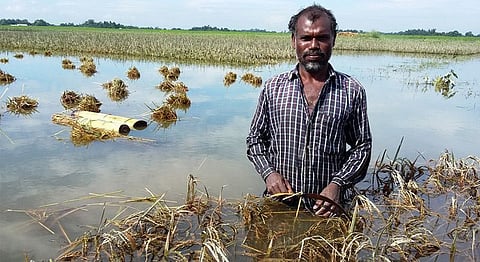
- HOMEGROWN WORLD
- #HGCREATORS
- #HGEXPLORE
- #HGVOICES
- #HGSHOP
- CAREERS
- ABOUT US
- CONTACT US

I’m still reeling from today’s heavy rainfall and water logging. Down to one bottle of water left in the house that I knew of, not to mention dwindling groceries, I couldn’t avoid the apocalypse outside my window any longer. Almost instantly, the knee-high water came pouring into my shoes as I dragged my feet to get to the grocery store just 50 feet away. The entire process took about 25 minutes–time mostly wasted in guessing where the potholes were. But even now, after a hot shower, warm food and a cup of coffee, I write this while muttering ‘I hate rain.” It’s in times like these that I (and too many others) tend to forget just how lucky we are.
We crib about how monsoon is a regularity in our tropical nation, and yet we’re seemingly never prepared for it. We lack the infrastructure – proper drainage, roads or urban planning. “This happens every year, everyone carries on with life, Mumbai survives and moves on,” I’m often told. Yet, here we are today, making headlines. For good reason, of course, there are thousands of people across the city that require assistance and care. So then why doesn’t this same logic and sentiment extend to Assam? Is it not an equally tangible part and parcel of our country?
After being led to several online reports (via a chance facebook post, what else), I’ve managed to learn that after multiple flood waves over 150 people have died, 2,210 villages submerged, close to 300 animals have died at Kaziranga National Park with 85% of the Park under water following the second wave of floods. These are no small numbers or occurrences.
Much like Mumbai, Assam is a region which is tremendously affected each year by the monsoons and the possibility of floods, and each year we shrug it off as a recurrence of a natural phenomenon that the country ‘should have been prepared for.’ No different from Mumbai? Wrong. It’s effects are more complex and far-reaching in this North-eastern city. A calamity that hits thousands, even lakhs of people living around the flooding Brahmaputra where there is increasing amounts of soil erosion. It’s the kind of guaranteed annual tragedy that demands both preparation and evacuation at a serious scale. What we see today, all over the country, especially in times of heavy rainfall are the effects of human encroachment on uninhabitable land, lack of proper urban planning, infrastructure and environmental degradation as the climate the world over changes because of our abuse of nature and its resources.
The Prime Minister has allocated relief funds in crores, even Madhya Pradesh contributed INR 2 crore to the State’s fund, as well as 82 relief camps and distribution centres across five districts, where 23,545 are taking shelter. How many years do we witness such government inaction until the worst hits and lives are lost? It’s coming close to a point that even the on-ground relief work being done, boats sent out and centres set up are not enough. Assam breaks down each year at this time, then rises only to be hit by deluges again – a destructive cycle that needs special development, infrastructure and plans to break. While the floods may have eased up at the moment, there is still a lot of work to be done.
Is our dismissal of the North East and all its ongoings so grave that we rarely give it enough importance to talk about it? And if we don’t even know about it/ talk about it, how likely is the government to feel pressure to actually do something about it? As untrustworthy and biased as our media channels may be sometimes, we cannot deny the power it holds in disseminating information to general citizens across the country.
Awareness of the situation increases possibilities of people reaching out to people in Assam, as well as Bihar and Gujarat or any other region that falls outside the major metros, to offer help and assistance in any way they can. The purview of the government, as well as us ‘city folk’, needs to extend beyond our state boundaries.
We can start by talking, listening and reading about a part of India that’s too often neglected.
ASSAM
Emergency helpline- 0361-2237219/2237460
Toll-free number: 108, 1070
Disaster Management Services Helpline: 1079
You can donate and help Oxfam India carry on relief work across all flood hit areas in the North-East, Bihar, Gujarat and Uttar Pradesh. Click here for more information about what they’re doing and find out how you can contribute.
Help The Centre for Wildlife Rehabilitation and Conservation and the Wildlife Trust of India carry on relief work for Kaziranga National Park and its animals by donating here.
